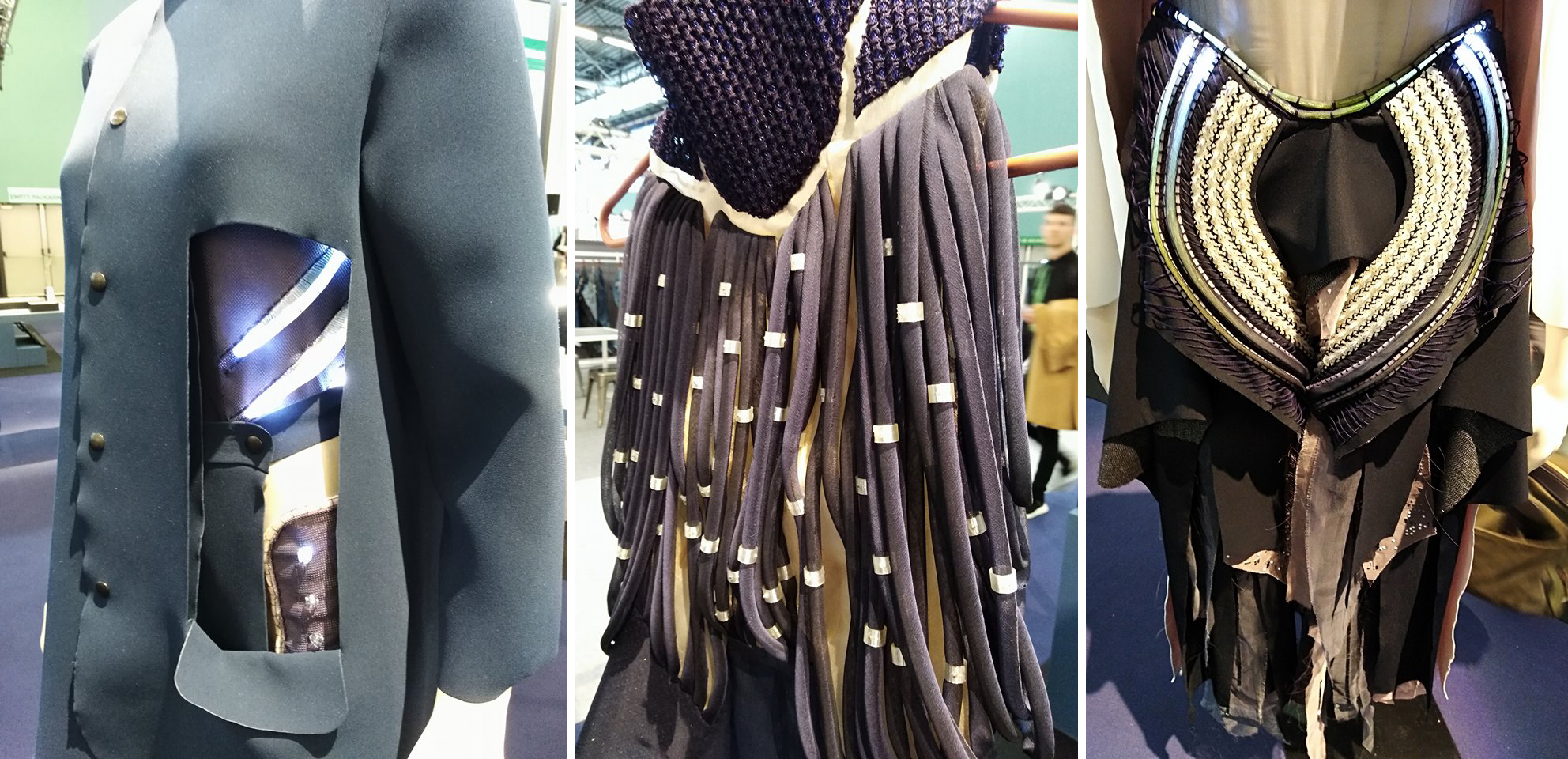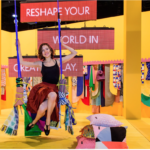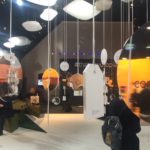To decode future trends
Wearable Lab Conferences at Première Vision, Paris sought to support the transformation of the fashion sector by launching the Wearable Lab: a space at the heart of the show designed to showcase the Fashion Tech players.
In February 2018, the Wearable Lab expanded into a village entirely dedicated to Fashion Tech. Structured around 4 areas, its goal is to present an international selection of materials, products and services to serve as sources of experimentation for the fashion industry:
R&D, materials/components and start-up, an inspiring exhibition showcasing Clara Daguin’s design process, featuring an exclusive design made for the occasion, and a program of conferences around the subject of fashion technology.
Let’s have a look back at the 3 main roundtables moderated by Vincent Edin which helped professionals analyze, think forward and decode the rapidly growing fashion tech ecosystem.
Imaginative Designs and Creation in Fashion Technology
Speakers: Pascal Morand (Executive president of the Fédération de la Haute Couture et de la Mode), Clara Daguin (Fashion Designer), Bradly Dunn Klerks (Senior Innovation Expert for the Arts and Technology).
Around the theme of creation, the conversation went on how fashion technology inspired the speakers. Often seen as a threat, technology in the collective imaginary can sometimes be pictured as a dystopia. The future, as depicted in TV shows like Black Mirror, can indeed be a very frightening one. So what about fashion technology? To Mr. Morand, it is both a threat and an opportunity.
“Maybe the first thing is to put a short definition on what we intend when talking about fashion tech: in French we say “technologie de la mode”. It’s nothing new, it was maybe the first technology, clothing and textile. In fact, what we can say is that it is linked to the 3rd and 4th revolutions – starting with the digital revolution, and now spreading around to numerous technologies. And the digital factor is playing a very important role, because without the huge progress of the software that we are experiencing, we couldn’t do what we are doing now. And that is Fashion Tech. It is the part of fashion linked somehow to the Industry 4.0. movement and revolution.” Pascal Morand.
In terms of imaginary, according to Mr. Morand, fashion technology has considerable implications. Traditionally in the fashion environment, technology was something that professionals from the industry were supposed to cope with (CAD, weaving machines, etc…), and now, he said, “new doors were opening”.
“But when we talk about the link between imagination and technology, we have to precise that it goes in both directions. Because technology is by itself firstly inspired by imagination, now we are far beyond the traditional rational approach on that, and that is typically a 21st century factor.”
On the subject of the fashion industry being influenced by tech giants, Mr. Morand shared that a necessary dive into the very meaning of these technologies’ concepts was necessary, as they mix new aesthetics with what designers have to say.. “In the 20th modernism period, one of the most important things is in the Bauhaus culture, the relationship to the object, its function. What is it useful for? And then you have a 2 pretty packaging. Now we are over it. We don’t consume objects. We consume experiences. In an experience, the aesthetics aspect of the project and the product and everything is intertwined, and fashion is at the fore front of this. And it applies to many other sectors as well.”
An important vision, shared by designer Clara Daguin, who told us more about her inspirations. In her eyes, the inspiration technology gives her is more of a response to the general nature of the society, and how technology is now sort of embedded in our lives. Daguin’s father happens to be an engineer, and as the young she grew up, she used to find opened-up computers and chips everywhere in her house, and that was the starting point of her inspiration. She explained how she evolved from not really knowing what to answer when asked about the function of her creations, to being proud of it: “I’ve been asked that question so many times. “You’re putting a heart sensor in your creation, what is it for? Does it serve a function?” Before I said I didn’t know, but now I see it as an artistic approach, it brings something beautiful, it gives an emotion. So now I am more confident to say it is not here to make your life better, but rather to highlight the beauty aspect of it. It’s more an artistic approach. And for me, what I see in FT today, there’s always the need for functions. My creations are not useful for everyday use, they’re more to convey an emotion.”
A declaration that was very welcomed by Mr. Morand, “What Clara says is very important. Because sometimes, it is said or thought that technology or FT is driving again to functionalism. But if you have something which doesn’t bring an emotion, and only gives you function, it’s very simple, people will get bored. And this is why numbers of the first generation of some FT products didn’t meet success, so then for designers the question is, as always, to appropriate the constraints, in order to use them and then to escape from them to develop their own universe, which is very emotional. And then you see the tech and emotional value combine.” said Pascal Morand.
On the idea of designers being replaced by machines and AI, Pascal Morand took the time to define the two different facets of this technology: differentiating symbolic intelligence from deep learning. On the second one, he explained how AI could compose music or draw collections, after being nurtured with archives. But according to him, such a music would be listened once before being forgotten, as people get bored when artworks lack emotion.
Reminding us how designers actually do not care so much about technologies, Bradly Dunn Klerks gave an interesting opening to the discussion. What they want, he said, is a way to create everything they have in mind. To that, technology can help, and designers are starting to realize it.
“You embrace different technologies, different kinds of craftsmanship, and use that through the Science Art Tech Triangle. This triangle is very important and I think that the alchemists in the old days were on this kind of way of thinking, and inventing, researching and I think that we are now we’re heading to the designer embracing that and being inspired by that, and thus becoming a new kind of an alchemist.”
Evoking the use of technology as a soft power tool for governments, Bradly Dunn Klerks shared his vision on how technology can be a tool to recentralize production back into our countries. Pascal Morand, putting the idea into perspective, reminded that technologies also have their limits, and that we need to test them to see what is possible.
Through the example of flexible material advances in 3D printing, he highlighted how so many things are still at the research stage. He also mentioned robotics automation, saying how complicated it is to apply the process to the fashion industry, in comparison to sectors such as automobile.
To close the conversation, Vincent Edin asked Pascal Morand about the pace of innovation versus the time-consuming ethical questioning and how sometimes asking too many ethical questions can be a way to lose markets and make us late adopters.
“These ethical questions are extremely complex questions. We know that somehow, the two main challenges of today are technology and sustainability challenges, we always have to keep that in mind. And the problem is that with technology, it is a marvelous thing and the most awful thing at the same time. So what can we do with that? We know that also it is a wonderful field of possibilities, and also what it has to do with creativity, for us, and by us I mean the FHCM and Première Vision and the eco-system, it is very important, it’s a battle for a humanistic vision of creativity, it’s embedded in ourselves in our culture, in our strategy, in our desires everything. We always have to wonder how tech can help us be more human & creative? We have a different words for it, in English we say Design, and in latin cultures it is Création, — added Pascal Morand — which is somehow mystical… But still, it is creativity. And now, the question is how do we work on that? This partnership between PV and PFW is to make sure this city gets stronger in creativity and technology, and mixing the two, especially in the field of fashion.”
A statement that was completed by Bradly Dunn Klerks, highlighting how important investment are in this space: “Technology is expensive, just look at the phone in your pocket, every person here, every two years buys a new phone. So when speaking about education, we must speak of investments, the industry has to support the schools more, the academic, it has to work on both ways. It’s not only the responsibility of the schools, because they can invest in machines, and then these machines get outdated 4 or 5 years after. So we have to start the conversation around how the industry has to support this.”
A great way to close the conversation around creation and technology, and move up to the one we will be having over the next few years: how to train the future designers to tools that constantly evolve?
Emerging Technologies & Industry Mutations
Intervenants: Kirsty Emery (Unmade), Muchaneta Kapfunde (Fashnerd), Philippe Ribera (Lectra)
The 2nd round table started with a quick attempt to map where the Fashion Tech revolution is coming from in the world nowadays. But can we consider that fashion innovation capitals exist yet?
Not yet, according to Muchaneta Kapfunde, editor-in-chief of FashNerd, it’s a global phenomenon. “At the moment fashion innovation is not concentrated into one spot. Every city happens to be building technology in different ways: in the end, when it comes to technology, it’s not just taking place in a specific part of the world, it’s taking place everywhere: everybody is contributing to Fashion Tech, making it more of a globalized and atomized phenomenon rather than a concentrated one in a specific area of the world. However, it seems the real frontrunners of the Fashion Tech revolution are new, small actors, with many new companies popping up at the moment. Also, more and more Universities across the world are currently creating Fashion Tech programs, meaning that future designers that will soon become professionals will have both technology and fashion backgrounds and experiences, rather than just one of those.”
Trying to sort out the benefits of the integration of technology to fashion for consumers through the personalization lens, Philippe Ribera, VP of Innovation at Lectra, believes that it will be necessary to bring consumer’s needs in the manufacturing process.
“Industry 4.0 – said Philippe Ribera — is a project for the next 20 to 50 years so it’s pretty hard to assess how long it will take. Nothing will end in 3 to 5 years. But for it to become a reality, we need to move step by step. Process by process. Is everyone or every company ready to produce on demand? Not at 5 all. Is there a market for everybody to produce on demand? Probably not. To me, it all comes down to who you’re targeting, when do you want to target them and how you do it. In the next 3 to 5 years, you’ll see some change, but the biggest one will mostly happen in something like 5 to 10 years.”
Such a conversation inevitably leads to the issue of data. The problem is not data itself, or obtaining it, but rather the amount of intelligence put into the understanding and use of this data, in order to make something out of it. Because of this, defining a precise goal in the use of data is key in order to start to work on what Philippe Ribera calls a “predictive model ”.
Thus, from the data perspective, the main issue isn’t about gathering it but analyzing it in a way to define a precise model to be sure that brands have the right information and use it in a relevant way.
However, some serious threats to the industry remain, as big tech competitors like Amazon and Alibaba already know what people want throughout the world and are efficient in delivering it. One might doubt they are able to apply it to the fashion industry, but such actors indeed have the data, know how to use it relevantly and have a serious edge from a digital marketing perspective making it a credible risk for the fashion industry. Nevertheless, these competitors might have a hard time competing with fashion houses on the field of creativity, which might prove to be more challenging. Currently, many tech companies (such as IBM) are already experiencing with various ways of leveraging data to boost creativity. Such cases show that AI is going to be something that designer’s will end up implementing to their products in the future, helping them create what’s actually desirable as opposed to what they believe people want.
“Artificial Intelligence loves us – told us Muchaneta Kapfunde –. It gets better and better and better as it goes along. It will play a very key role in the fashion industry and it will also help designers use data to create products that are actually what consumers want to wear.”
Back on the personalization theme, after a short introduction of Unmade by Kirsty Emery, panelists discussed customer’s hunger for personalized product. Looking at Nike’s results on the segment (20 to 30% of Nike’s online sales are personalized products), it is reasonable to consider that the current hunger for customization is endless. As a huge area for Nike and a market segment that has been in constant growth since they launched, Nike iD is currently one of the first really big customization platforms that is available and really open at the same time. “I’m also a designer – said Kirsty Emery — so I like having a choice, but I end up feeling like it’s overwhelming having so much possibilities available. Also, Nike iD is so open that it’s also opened to making ugly designs. the difference with Unmade is that we position ourselves on curated customization rather than design.”.
But how big of a trend customization is? Muchaneta Kapfunde believes that first and foremost, technology gives us choice, the choice of doing what we want to do. Consequently, she believes personalization is going to be massive in the future, particularly in retail tech. Something that Philippe Ribera pretty much agreed to: “We forgot for a while that the heart of our business was the consumer. If we don’t come back altogether to the consumer then there’ll be no business. The challenge is to provide the tools, the processes, the skills required to help brands speak with their consumers. We can’t forget that any kind of tool that help you communicate with your customer base is a good tool for your business. We need to collaborate. It’s a co-creation work everywhere. Even in technology. So, in Fashion I think it’s the main issue.”
The remaining hurdle might come from the price points for customizing. But far beyond that, the coming personalization market might become a real turning point in the way we consume fashion as individuals:
“I think the biggest question here is” In which world do we want to live?”. At the same time, Primark is booming like that. Probably 80% of consumers in the world are very happy to go toPrimark. We spoke about these very limited number of people today able to pay a premium price to acquire some personalized garments, yet the answer isn’t in the technology, nor the brand, but lies in the question “what life do you want to have in the next 5 to 10 years?”
Discussing the prices of goods, customized or not, unavoidably lead panelists to express their views about Fast Fashion. Is showing the difference between a Primark product and your brand enough? Will it help consumers make better decisions, even though we already know these aren’t motivated by the sole fact that it’s cheaper? When it comes to pricing, Muchaneta Kapfunde believes that it ultimately comes down to education: consumers need to know what their options are, so they will be able to make better decisions not only based on the fact that it’s cheaper, but also on other facts. An approach that millennials and generation Z youngsters may have already naturally embraced: “I believe the younger generation have a very different frame of thought: they’re more conscious shoppers, they want transparency, they want to know what their products are made of and where they are from. The young ones are very much aware that they need to protect their planet. This is something they’re learning now, as youngsters at a young age and because we were raised in consumerist societies, that shows us that we need to rewire our brains and change the way we think. The positive side is that because of its many issues and thanks to these youngsters, Fast Fashion is dying a slow death.”
Indeed, corporate responsibility might be one of the key element for fashion brands to distance themselves from Fast Fashion giants. However, like VEJA founder Sebastien Kopp once said, responsibility as a reason to believe is no good for sales, because in consumer’s mind, it means ugly clothes. Thus, efforts are still needed to position sustainability and corporate responsibility as something that strengthens a brand’s unique selling proposition and, ultimately, convince people that they can buy sustainable and still be fashionable.
“Sustainability is something really important — Kirsty Emery asserts –. It should stick within the industry in a similar way that great design should sit within the garment. If something is designed well, whether it’s a garment or something else, you shouldn’t be able 7 to see that effort. It should be there, it’s going on and it’s happening in the background. It’s an additional plus, it’s about having something that’s not just the icing on the cake anymore. It’s something which is built-in throughout.”
To end this round-table, panelists were invited to express their views on the social acceptability of these technologies and the trust in wearing connected textiles. As we witnessed recent fiascos around data and the many information that leaked (Strava, Uber, etc.), many concerns remain when it comes to guaranteeing people’s privacy. The consensus among panelists seemed to be that this issue might be entrusted to the blockchain technology. However, while it’s renowned to be impossible to hack, our common experience with technology taught us that nothing is infallible. But the amount of trust we can put into this innovation equates our willingness to share our data. The common belief is that younger generation don’t mind sharing these precious information, considering their habit to share content naturally and happily. However, does this really means that the youngsters don’t care about data? Some might beg to differ…
Fashiontech’s Economic & Strategic Territories
Intervenants: Camille Benech (Google, Global Brand Lead for Luxury and Beauty en France), Cédric Lowenbach (Bpi France), Bradley Quinn (EIRL Bradley Quinn).
While listing the main shifts happening in the Fashion industry in terms of energy (solar, renewable energy) and how it might change the approach to the market, Bradley Quinn told us something surprising: in the US, Fashion is pretty much out of this revolution at the moment. In fact, projects are mainly positioned as Apparel. When American pioneers talk about Wearable Technology finding a market, the most obvious one for them seems to be sportswear/activewear, which basically makes sense considering that the applications of the currently available technologies that power the movement are mainly focused on health, convenience and personal performances. At some point, it might then become necessary for the Fashion industry and entrepreneurs to change track and claim that the Fashion consumer is a targeted audience. Still, it’s up to big companies working with startups to overcome the key risks for things to move forward: make the technology washable, find a safe and sustainable power source…
“There are very big issues to overcome for the wearable industry. Bigger brands have budgets for such development, but they aren’t really aware or don’t have the willingness to face these obstacles yet. What is inspiring for the future is that this big gap between startups and big companies is very slowly starting to narrow. Once that gap is closed, I think wearable technology will have the opportunity to really find a market. ”
In order to finance these efforts and overcome the current hurdles, the BPI created two funds dedicated to Fashion: one called “Mode et Finance” (dedicated to small startups with more than €500 000 in revenues, like for instance AMI Paris, Christophe Lemaire, Bonne Gueule…) and another fund baptized “Patrimoine et Création” that helps sustain the growth of more developed businesses (companies with revenues up to €100 million). To ensure these investments are beneficial, the most watched KPIs to obtain these financial supports at the moment are the level of revenue, the importance for small brands to be led by two partners and, most importantly, the business model. Indeed, BPI has tracked the evolution of innovative fashion companies with great attention for years: since 2005, they went from selling through wholesalers to developing their own network of retailers and finally, selling through digital channels and communities. Yet, while many financial opportunities exist in the country, the main hindrance to French startups’ growth might be that entrepreneurs tend to be too cautious: in fact, many have too much of a domestic vision, which is why BPI pushes them to internationalize their companies, even at a very early stage, especially in Fashion (which is obviously viable, considering that such startups might already be sourcing or producing outside of France, thus starting as international companies).
To get a better overview of the Wearable Tech ecosystem and how to make it work, Camille Benech offered us some insights into Google’s approach through its Advance Technology and Projects Team (ATAP), the unit that brought to life the Jacquard project. In short, this unit is made up of a very small team dedicated to innovating in a very short period of time, in order to go big on technologies that are going to create big shifts within the next 3 to 5 years. As of today, the ATAP took part to more than 600 projects and Jacquard is positioned as a platform giving the yarns to partners and then providing the full end-to-end experience (the app, the engineers and the work around UX that are absolutely necessary); which are the most important and costly parts in the development of such products. Ultimately, Google’s goal is to become an enabler of wearable products and connected garments.
“Levi’s was the first partner for Jacquard – added Camille Benech, Google.– This year, we are going to announce new partnerships coming to life with new brands and totally new design they are going to do. It could be anywhere: the yarns are so invisible, it’s totally seamless so the idea is that we welcome any brand that has the intent of making something useful, because the use cases are really important to us. We don’t consider this new kind of cloth as a garment, nor a wearable, but as an entirely new area. It’s kind of like half each.”
What’s also interesting in the project is that, while the cloth remains the same, the dedicated app evolves according to its wearer’s use. This is a true innovative step forward: for the very first time in Fashion’s lifetime, app releases are what changes the usability of a given garment. As a result, new releases and new features continuously enrich the function of the garment, with usages tailored to the needs of users.
For the rest, Google really gives full power to brands, since they are the ones that have the know-how to create and sell garments (since the big tech company does not have the skills when it comes to tastes, design and manufacturing processes). The experiment as the merits to show that it is important for each actor to stick to what they do well, to collaborate as specialists for the partnership to come to fruition. Nevertheless, the presence of such huge competitors might come along with potential nefarious effects able to hinder smaller competitors:
“I consider this jacket has a double-edged sword for investors and entrepreneurs — Bradley Quinn of EIRL Bradley Quinn said –: on one hand, you can see if it takes offhand becomes very popular, you can open a huge new market for wearable technology this way, but on the other hand, I know that, for small brands to produce this jacket, they would have to sell it for double the price in order to have a return on investment. These prices (350 $) might push smaller entrepreneurs out of the market. However, the creative industry has a culture of innovation right now, so maybe the entrepreneurs would be able to innovate with materials and production in a way that big mainstream brain hasn’t thought of, and manage to produce wearable garments at 9 a cheaper price.”
Finally, one of the greatest opportunity for wearable garments might exist through the existing merger between the cultural world and Fashion: the art world, and more particularly Performance art and the Music industry, which are interesting fields for wearable tech to take off, bringing another dimension to experiences brought on stage by artists and bridging a new gap for the tech field to thrive.







